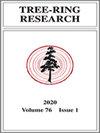采集岩心对空心树进行定年——苏格兰松研究纪要
IF 1.1
4区 农林科学
Q3 FORESTRY
引用次数: 0
摘要
具有完整树环的抽象增量核心在树龄树木年代学研究中至关重要。然而,由于打嗝,不可能总是从树上获得完整的核心,因此需要探索替代方法。我们测试了一个斜芯和一个直芯的集合,从12棵苏格兰松(樟子松)树的胸围高度到达坑。我们模拟了每个直芯的缺失内侧部分(由假设打嗝引起),并使用多种方法估计了斜芯和直芯的树木年龄。然后,我们比较了从受腐烂影响的14个空心松中获得的年龄估计,发现部分直核(17.75%)的估计的平均绝对误差低于斜核(47.58%)。我们得出结论,斜芯不适用于松树,因为芯尝试失败率高,芯与树木茎的时间中心之间距离大。我们建议收集两个直接朝向核心中心的核心,以增加获得准确年龄估计的机会。摘要:在各种树木年代学研究中,从树木中收集的调查岩芯对于确定树木年龄非常重要。然而,空心树不允许获得包含所有生长年轮的样本,因此有必要探索替代方法。因此,我们测试了在12棵健康的苏格兰松(樟子松)上收集两个胡萝卜(一个指向树的几何中心,另一个倾斜避开树干的中心)。在每个瞄准中心的样本上,模拟了一颗腐烂的心脏。从该不完整样本中估算树木的年龄,然后使用适当的方法从倾斜样本中估算。将这些估计值与参考年龄进行比较。截短直样品的平均绝对误差(17.75%)低于斜样品(47.58%),然后在14个空心松上测试了该方法的适用性。由于取样失败率高,以及胡萝卜与树木时间中心之间的距离太大,斜钻取胡萝卜不适合松树。建议收集两个直立样本,以增加获得可信年龄估计的机会。本文章由计算机程序翻译,如有差异,请以英文原文为准。
Collecting Cores to Age Hollow Trees: A Research Note on Scots Pine (Pinus sylvestris)
ABSTRACT Increment cores with intact tree rings are crucial in dendrochronological investigations to age trees. However, it is not always possible to obtain complete cores from trees because of rot, so alternative methods need to be explored. We tested the collection of one oblique core and one straight core reaching the pith at breast height from 12 sound Scots pine (Pinus sylvestris) trees. We simulated a missing inner part (caused by hypothetical rot) from each straight core, and estimated the trees' ages from both the oblique and straight cores, using several methods. We then compared the estimates to ages obtained from the complete cores, and found that the mean absolute error was lower for estimates from partial straight cores (17.75%) than from oblique cores (47.58%). We then obtained oblique cores from 14 hollow pines affected by rot, to test the applicability of this practice to real rotten trees. We concluded that oblique coring is not suitable for pine trees because of high failure rates of coring attempts and large distances between the cores and chronological centers of the trees' stems. We recommend the collection of two cores aiming straight toward the center of trunk to increase the chances of obtaining an accurate age estimation. RÉSUMÉ Les carottes de sondage collectées sur les arbres sont d'une grande importance dans diverses études en dendrochronologie pour determiner l'âge des arbres. Cependant, les arbres creux ne permettent pas d'obtenir des échantillons comportant toutes les cernes de croissance, rendant nécessaire l'exploration de méthodes alternatives. Nous avons ainsi testé la collecte de deux carottes (une visant le centre géométrique de l'arbre, l'autre oblique évitant le coeur du tronc) sur 12 pins sylvestres sains (Pinus sylvestris). Sur chaque échantillon visant le centre, un coeur pourri a été simulé. L'âge de l'arbre a été estimé à partir de cet échantillon rendu incomplet, puis à partir de l'échantillon oblique en utilisant les méthodes appropriées. Ces estimations ont été comparées à l'âge de référence. L'erreur absolue moyenne était plus faible pour les échantillons droits tronqués (17.75%) que pour les échantillons obliques (47.58%). L'applicabilité de cette méthode a ensuite été testée sur 14 pins creux. La collecte de carottes de sondage obliques n'est pas adaptée aux pins en raison d'un fort taux d'échec d'échantillonnage, et de la distance trop importante entre les carottes et le centre chronologique de l'arbre. Il est conseillé de collecter deux échantillons droits, pour augmenter les chances d'avoir une estimation vraisemblable de l'âge.
求助全文
通过发布文献求助,成功后即可免费获取论文全文。
去求助
来源期刊

Tree-Ring Research
农林科学-林学
CiteScore
2.40
自引率
12.50%
发文量
15
审稿时长
>36 weeks
期刊介绍:
Tree-Ring Research (TRR) is devoted to papers dealing with the growth rings of trees and the applications of tree-ring research in a wide variety of fields, including but not limited to archaeology, geology, ecology, hydrology, climatology, forestry, and botany. Papers involving research results, new techniques of data acquisition or analysis, and regional or subject-oriented reviews or syntheses are considered for publication.
Scientific papers usually fall into two main categories. Articles should not exceed 5000 words, or approximately 20 double-spaced typewritten pages, including tables, references, and an abstract of 200 words or fewer. All manuscripts submitted as Articles are reviewed by at least two referees. Research Reports, which are usually reviewed by at least one outside referee, should not exceed 1500 words or include more than two figures. Research Reports address technical developments, describe well-documented but preliminary research results, or present findings for which the Article format is not appropriate. Book or monograph Reviews of 500 words or less are also considered. Other categories of papers are occasionally published. All papers are published only in English. Abstracts of the Articles or Reports may be printed in other languages if supplied by the author(s) with English translations.
 求助内容:
求助内容: 应助结果提醒方式:
应助结果提醒方式:


